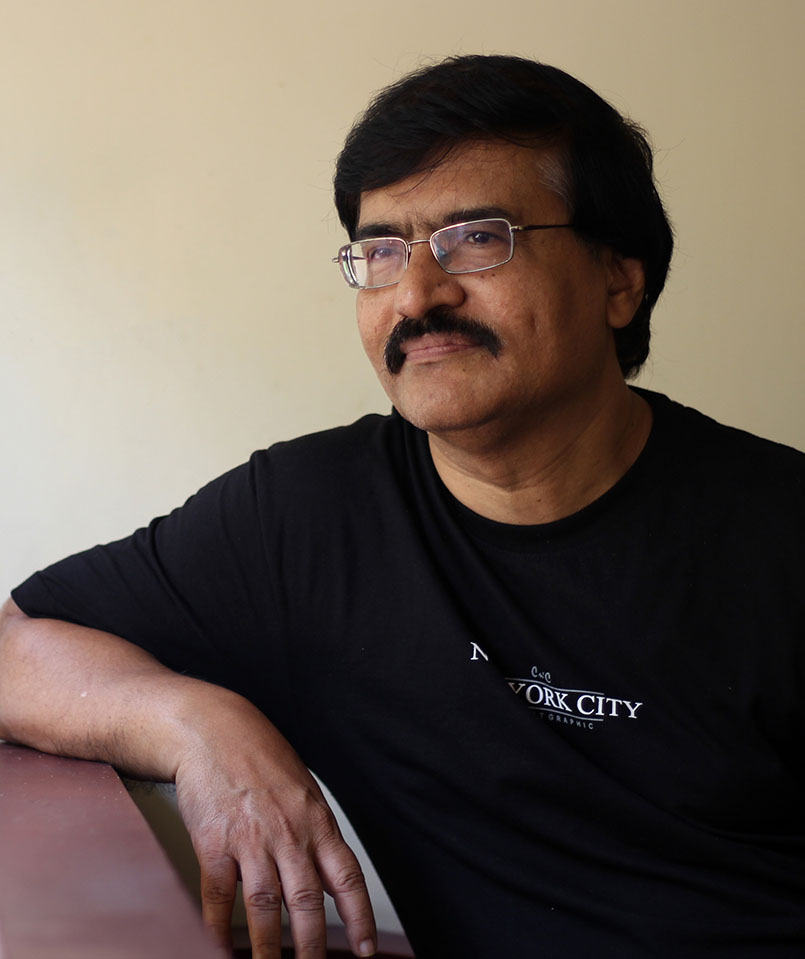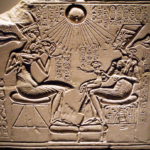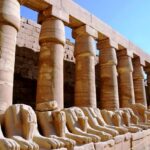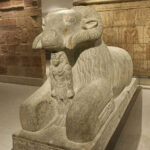“The Lord redeems the soul of His servants,
And none of those who trust in Him shall be condemned.”
(The Bible, Psalm 34:22)
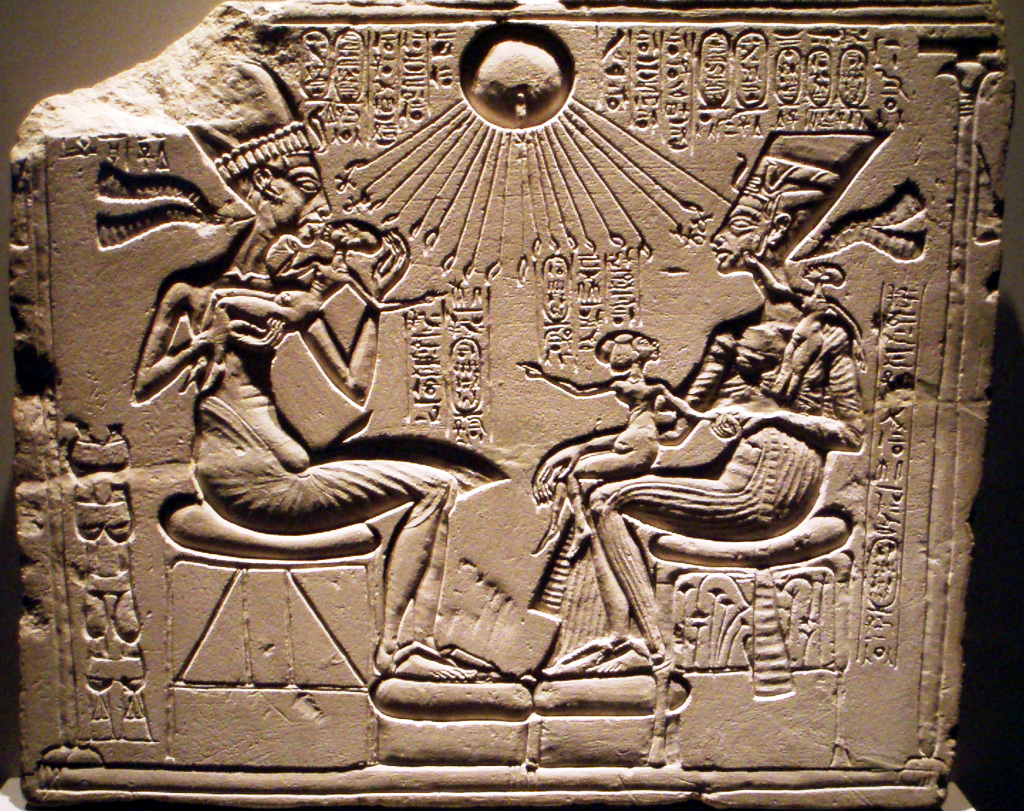
Akhenaten and Nefertiti with their Children
Pharaoh Akhenaton had ascended the throne of Egypt some 3400 years ago. His religious convictions made the youthful Pharaoh revolt against Egypt’s traditional religious system and the predominance and corruption of its priesthood.
In the great temple at Karnak in Thebes, there was a large harem, supposedly housing the concubines of god Amen, but in reality for the amusement of the Amen priesthood. The young emperor did not approve of this sacred harlotry. The blood of the ram slaughtered in sacrifice to Amen stank in his nostrils. The traffic of the priests in magic and charms and their use of the oracle of Amen to promote religious obscurantism and corruption disgusted him. He abominated the obscene wealth and the lavish rituals of the temples. He wished to put an end to the growing hold of the priesthood on the nation’s life.
Here, we continue his story from Part-I:
Akhenaton realized that the priesthood of Thebes would resist his move to replace the existing polytheistic religion with his monotheistic religion worshipping the Sun-Disk. So, the Pharaoh decided to move his capital from Thebes. Thus, in the sixth year of his reign, when Akhenaton was about seventeen or eighteen, he sailed down the Nile to look for an appropriate location for his new capital. At a place some 190 miles from the site of modern Cairo and nearly 300 miles from Thebes, on the eastern bank of the river, he discovered a spot where the limestone hills of the desert suddenly receded, enclosing a beautiful crescent-shaped bay, some three miles wide and five miles long. The place was lovely and serene. Akhenaton decided to build upon that virgin soil, the new capital of his dreams.
Hundreds of diggers and bricklayers, masons, carpenters, painters, sculptors, craftsman and artists of all sorts flocked to the site of the new capital. Stone quarries were opened in the neighbourhood, while Bek, “Chief of the sculptors on the great monuments of the king,” was sent to the south for red granite. Marble and alabaster, granite of different colours, ivory, gold and lapis lazuli, and cedar and various kinds of precious woods were brought from Upper Egypt and from Nubia, from Sinai and Syria… And within two years or so, temples, palaces, villas, cottages, gardens, lakes full of lotus-flowers and avenues bordered with lofty palm trees sprang forth from the barren sands.
The new city was smaller in comparison to Thebes, but a lot more beautiful. Its great temple of god Aton was a magnificent building. The shrines erected to the memory of the Pharaoh’s ancestors, could match with the most beautiful religious monuments of Egypt. The palace of his parents in Thebes was marvellous. And the king’s new palace was more resplendent. The whole place was planned with delicate taste and supreme elegance. Akhenaton named this holy city of his god Aton as Akhetaton (“Horizon of Aton”). This city is known in modern times as ‘Tell el-Amarna’.
Thebes, with the temples and palaces at Karnak and Luxor, rapidly decayed as government offices and financial support moved to the new capital. The territory around the new capital city was demarked as a domain belonging to the god Aton. In the cliffs on either side, fourteen large stelae (upright stone slabs bearing markings), were cut into the rock, bearing inscriptions determining the limits of the entire sacred district around the city. The district so laid out was about eight miles wide from north to south and twelve to seventeen miles long from cliff to cliff.
The temple of Aton had nothing of the mystery and sacred awe that generally filled the temples of the traditional gods. There were no dimly-lit lamps hanging from gloomy ceilings; no precious images buried in the depth of pitch-dark sanctuaries like stolen treasures in a deep cave. In the new city, a visit to the temple, even to the innermost altar, was but a natural transition from the all pervading radiance of the fiery Disk, from the blazing heat of the world vivified by His beams, to the worship of the unknown invisible Essence behind that light, behind that heat—of the Power, of the Soul of the Sun.
At different times of the day, bread and wine and frankincense and beautiful flowers were offered upon the altars to that invisible God, whose only image and symbol was the Sun. And clouds of perfume and waves of music went up to Him and disappeared, dissolved in the golden light of heaven. One was in the presence of an entirely new cult; of an entirely new spirit. But Akhenaton no longer attempted to act as High Priest himself. Instead, one of his favourites, Merire (“Beloved of Re”), was appointed by him to the office.
Although there must have been a nucleus of men who really appreciated the ideal aspects of the king’s teaching, many were chiefly influenced by ‘’the loaves and the fishes‘’. But there was one royal favour which must have been welcome to them all without exception. This was the beautiful cliff-tomb which the king commanded his craftsmen to hew out of the eastern cliffs for each one of his favourites. Akhenaton did not suppress the old mortuary practices. He believed that it was still necessary for a man to be buried in the “eternal house,” with its endowment for the support of the deceased in the hereafter.
But that “eternal house” was no longer disfigured with hideous demons and grotesque monsters which should confront the dead in the future life. Nor was there the magic paraphernalia necessary to meet and vanquish the dark powers of the nether world. Such things that had filled the tombs of the old order at Thebes were completely banished. The tomb now became a monument to the deceased; the walls of its chapel bore fresh and natural pictures from the life of the people in Akhetaton. Thus, the city of Akhetaton is now known better to us from its cemetery than from its ruins. Throughout these tombs, the nobles take delight in reiterating, both in relief and inscription, the intimate relation between Aton and the king. The nobles constantly pray to the god for the king, saying that he “came forth from thy rays,” or “thou hast formed him out of thine own rays”.
Either for the temple service or for personal devotions the king had composed two remarkable hymns to Aton, which the nobles had engraved on the walls of their tomb chapels. They are regularly entitled ‘’Praise of Aton by King Ikhnaton and queen Nefernefruaton”. A profoundly revealing portrait-bust of Akhenaton, discovered at Tell-el-Amarna, shows a profile of incredible delicacy, a face feminine in softness and poetic in its sensitivity. With large eyelids like a dreamer’s, a long, misshapen skull, a frame slender and weak… In short, Akhenaton was a Shelley called to be a king!
The young ruler lived in simplicity.. He had seven daughters, but no son. By law he might have sought an heir by his secondary wives. But he preferred to remain faithful to his wife Nefertiti (Nefernefruaton). A little ornament has come down to us that shows him embracing the Queen. He allowed artists to depict him riding in a chariot through the streets, engaged in pleasantries with his wife and children. On ceremonial occasions the Queen sat beside the Pharaoh and held his hand, while their daughters frolicked at the foot of the throne.
But all these joy, beauty and tranquillity could not have lasted for long. Into this simple happiness of the royal home came alarming messages from Syria. The dependencies of Egypt in the Near East were being invaded by Hittites and other neighbouring tribes. The governors appointed by Egypt pleaded for immediate reinforcements. Akhenaton hesitated. He was loath to send Egyptians to die on distant fields for an uncertain a cause. When the dependencies saw that they were dealing with a saint as their emperor, they were emboldened. They deposed their Egyptian governors and quietly stopped all payment of tribute to the emperor.
As time passed and as things went worse in Syria, the Pharaoh was becoming more and more alone—out of touch with his people, with his nobles, with his age, with the tradition of his country and with the tradition of the world. He was out of touch with the present and the past. Perhaps, he was out of touch with the future, too, for ever. He was becoming a man without roots in any soil and without a hold over any other men.
The Egyptians might have believed that their monarch was of divine descent. Yet his orders do not indeed carry the same weight as those of a triumphant king. For in armed success, there is a magic that commands respect. Unfortunately, Pharaoh Akhenaton failed to realize that one simply cannot be a saint and a sovereign at the same time! But, for Akhenaton, it was a question of principles. “Akhenaton definitely refused to do battle, believing that a resort to arms was an offence to God. Whether fortune or misfortune, gain or loss, was to be his lot, he would hold to his principles, and would not return to the old gods of battle.” (Arthur Weigall: Life and Times of Akhenaton)
Suddenly, the dependencies of Egypt became free. And Egypt ceased to be a vast Empire. Soon the Egyptian treasury, which had for a century depended upon foreign tribute as its mainstay, was running empty. Internal administration was in chaos. The saint king found himself penniless and friendless in a world that had seemed all his own. Perhaps, a time had come when nobody loved him apart from his devoted queen and a handful of faithful friends. Their love was soothing. But still he was alone.
It is clear from the evidence of the Amarna Letters that, had he consented to use violence, Akhenaton could easily have stemmed the tide of events and saved the Egyptian empire. Akhenaton seems to be the one king in history who, for the sake of a philosophy, actually lost a great empire. Several modern writers have criticized him for not using the military option. But, the one redeeming fact of his reign was that in spite of his revolutionary decrees against traditional Egyptian religions, not a single rising was reported in Egypt against his government, all through his reign. Akhenaton was popular enough among his subjects. But he was thoroughly hated by the priesthood. The Pharaoh could not guage the power of the priests. And that had led to his tragic fall!
There are portraits of Akhenaton which show us a thin, sickly face, with deep wrinkles each side of the mouth, and bones jutting out: the face of a young man worn out by sorrow and possibly also by some wasting disease. These portraits bear little resemblance to those of his early youth, except for the unbending determination that can be read in the king’s features. Given every allowance for the exaggerations and distortions as part of the “style” of the artists of the court, there can be no doubt that these portraits reveal to us something of the appearance of the Pharaoh at some stage of his life – probably at its last stage.
By the time Pharaoh Akhenaton had reached only the age when most great men have not yet begun to do the work for which they are born, he had already become a physical wreck. He apparently knew that his end was drawing nigh. He had no son, his eldest daughter was the heiress to the kingdom. At the age of twelve, Akhenaton gave her in marriage to a young man of royal blood named Smenkhkara. But Akhenaton knew that things would soon slip back to its previous state since the dispossessed priests of Amon were gathering more and more strength as news of the failing empire rapidly spread.
In 1362 BCE, Pharaoh Akhenaton died, when he was only about twenty-nine years old. His body, was buried in a tomb in the Eastern hills of the new capital he had built. We know nothing of his last days or of the circumstances of his death. We can only try to imagine of him gradually thrusting aside the burden of government after the elevation of Smenkhkara to the rank of co-regent, and living in retirement in his summer-house, in the midst of the beautiful gardens. Nefertiti, who was to survive him, waited upon him till the end. We may imagine Akhenaton gazing at the deep blue sky from his sickbed and in a last effort, lifting up his enfeebled hands in praise to the rising Sun as he died…
After the ephemeral reign of Smenkhkara, the priests of Amon regained its power. They swept the religion of Aton out of Egypt. Akhenaton’s second daughter, Makitaton, had died while yet a child. The priests forced his third daughter to change her name from Akhsenpaton to Ankhsenpamon and to marry an insignificant young noble, whose name was Tutankhaton. The priests renamed him from Tutankh-aton to Tutankh-amen. They placed Tutankhamen upon the throne of Egypt as their puppet. Tutankhamen made his peace with the priesthood and returned to the former capital Thebes. He announced to a rejoicing people the restoration of the ancient gods.
The words Aton and Akhenaton were effaced from all the monuments. The priests forbade the name of the heretic king to pass any man’s lips and the people referred to him as “The Great Criminal.” The names linked to god Amon that Akhenaton had removed earlier were re-carved upon the monuments. The feast-days that Akhenaton had abolished were renewed. Everything was as before.
Akhenaton’s City was pulled down stone by stone, and ruined so completely that men forgot where it had once stood. The body of the Pharaoh was torn from the tomb in the Eastern hills and was taken to Thebes. It was reburied in the Valley of the Tombs of the Kings, near Thebes. Akhenaton’s name was effaced from his own coffin and even from the ribbons of gold foil that had encircled his mummy. Since his tomb was not sealed properly, the mummy soon disintegrated.
The triumphant priests composed a hymn of hate, now preserved upon an ostrakon (fragments of pottery or stones that have writing scratched into them) in the British Museum. It says:
“Thou findest him who transgresses against thee;
Woe to him who assails thee!
The sun of him who knows thee not goes down, O Amon!
But as for him who knows thee, he shines.
The abode of him who assailed thee is in darkness; but the rest of the earth is in light.
Whoever puts thee in his heart, O Amon,
Lo, his sun dawns.”
The priests of Amon got what they wanted – the death of the heretic ruler and a restoration of their powers. The world obeyed them. And it has continued obeying them ever since, cherishing its manifold superstitions and paying homage to its tribal gods.
Akhenaton, the saint, was soon forgotten. The priests of Egypt had believed that no man would ever learn about the Pharaoh whom they had condemned. And for 3,300 long years, their curse held good. But no truth would be suppressed for ever. In January, 1907, a skeleton—all that remained of the world’s first rationalist and oldest Prince of Peace—was discovered by English Egyptologist Arthur Weigall in a tomb in the royal necropolis near the ruins of Thebes. At the foot of the coffin was inscribed the prayer, most probably composed by the dead king himself, in praise of the One God. On the top of the coffin were the name and titles of the Pharaoh: “The beautiful Prince, the Chosen-son of the Sun, King of Upper and Lower Egypt, Living in Truth, Lord of the Two Lands. Akhenaton, the beautiful Child of the living Aton, whose name shall live for ever and ever.” The name had been erased, but the titles were sufficient to reconstruct the inscription in its whole. A few years later, Arthur Weigall published his beautiful book: The Life and Times of Akhnaton.
Throughout the reign of Tutankhamen and those of his immediate successors, the spoils of every war and the lion’s share of taxes from the conquered provinces, went to the temples and the priests. Under Pharaoh Rameses III, the temples had possessed 107,000 slaves (constituting one-thirtieth of the population of Egypt), 750,000 acres of land (one-seventh of all the arable land), and 500,000 head of cattle. They received the revenues from 169 towns in Egypt and Syria. All this priestly property was exempt from taxation. Rameses III had showered unparalleled gifts upon the priests of Amen, including 32,000 kilograms of gold and a million kilograms of silver. Every year he gave them 185,000 sacks of corn. The treasury ran empty and more and more the people starved in order that the gods might eat more and more!
Today, some three thousand and three hundred years Akhenaton, the world still remains under the steely grip of religious traditions and its priesthood. It is ridiculous that in this age of modern science people would kill each other on earth in order to protect their gods in heaven! And the priesthood continues to fatten itself sucking up the blood and sweat of the ordinary believers. And people still starve so that gods eat to indigestion!!
And people are told: “Blessed are you that hunger now, for you shall be satisfied” (The Bible, Luke 6:21).
Pie in the sky…!!
Post Script:
The image above is a small house-shrine stele made of limestone showing Akhenaton and Nefertiti with three of their daughters. This historic depiction provides a rare opportunity to view a scene from the private life of the king and queen. The daughters are being held and caressed by their parents in the presence of their god Aten. In the center of the scene is god Aten, represented as a sun disc with sunrays ending in hands proffering ‘ank’-signs (life-signs) to the royal couple.
Select References:
- Will Durant, The Complete Story of Civilization
- Sigmund Freud, Moses and Monotheism
- Savitri Devi, Son of the Sun
- Ahmed Osman, Moses and Akhenaten: The Secret History of Egypt at the Time of Exodus
- James Henry Breasted, A History of Egypt from the Earliest Times to the Persian Conquest
- James K. Hoffmeier, Akhenaten and the Origins of Monotheism
- Jan Assmann, From Akhenaten to Moses Ancient Egypt and Religious Change
- Sir Wallis Budge: Tutankhamen, Amenism, Atenism, and Egyptian Monotheism
